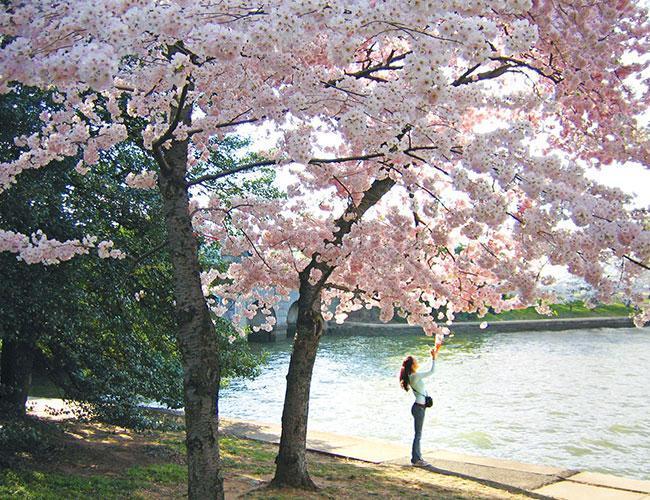
Most of the northern hemisphere welcomed spring with unexpected snowfalls. April photos picturing cities covered with a white blanket of frost was shared with frustration, because normally April must be the month when this white blanket has to be a formed by a bed of flower petals. Interestingly, some places welcomed spring earlier than normal; the famed Sakura season of Japan opened as usual in Okinawa in late January, and in Tokyo it commenced nine days earlier than anticipated, with the first blossoms seen on March 17. Nowadays, while the wonderfully blossoming Sakura cherry trees remain only to be seen on the northern Hokkaido island and in higher places in Japan, soon most parts of the country will be covered with “sakura snow,” a pinky white blanket of falling petals. With the Sakura season nearing an end, it is time to talk about flowers.
Though cultures world apart, if there are some similarities to be drawn between Turkish and Japanese cultures, one has to be the admiration for flowers. Like the Japanese, the Ottomans had a soft spot for flowers. Floral patterns appeared everywhere from textiles to tiles, and Ottoman art was full of depictions of tulips, roses, carnations, hyacinths and violets. While the bite-sized haiku poems are dedicated to cherry blossoms in Japan, most poems are adorned with roses and all sorts of flowers imaginable. While queen mothers and wives of sultans were given names of flowers, flowers were also admired much in confectionary, jams and sherbets, for the Ottoman palate sweetness was best enjoyed with the delicate perfume of flowers.
If Japan turns into a kaleidoscope of a myriad of pink shades, the color of Istanbul used to be shades of purple. The imperial city, with its Byzantine emperors dressed in royal purple, continued to love the color from everything to deeply magnetic aubergine purple in Iznik tiles, to velvety embroidered kaftans of the sultans. Even Istanbul cuisine has shades of purple, from the glistening mussel shells stuffed with an almost purplish rice with blackish purple currants to now elusive violet sherbets and candies, to still popular hundreds of eggplant dishes cooked with their purple skins on. Istanbul’s cuisine has its good share of purple shades. But what signify Istanbul best are the Judas trees. In late April a lighter shade of purple, the pinkish-mauve Judas tree blossoms start covering the flanking shores of Bosphorus with a joyous node to spring. Once upon a time, the blossoming Judas trees used to be what Sakura is to Japan.
It seems that with global warming sakura might become more ephemeral than ever. As the seasons shift from winter directly to summer, and then unexpectedly back to winter, we sometimes not even have proper winters at all to enjoy the beauty of spring. The real thrill of having a sakura season is the joy it brings after a heavy winter. This joy might be in danger of extinction. We did not have a real winter in Istanbul this year. We have lost most of the purple cloud of Judas trees in Istanbul to heavy urbanization. Now the tulips seem to be in fashion, in line with the quest of neo-Ottoman revival, nostalgic of the Tulip era when indulgence in lavishness and luxury was at its peak. The Tulip era, hence its name due to an elevated fondness for tulips during that period, was short-lived. Living splendiferously was not sustainable and did not last long. Nothing lasts forever, as best understood in the Japanese culture, sakura stands for the borderline between life and death.
Life is transient, so best is to admire the spring now, becoming more and more elusive with the global warming. Carpe diem!
Fork of the Week: The recently opened Isokyo restaurant in Raffles Istanbul at Zorlu Center is featuring pan-Asian cuisine aiming at building a bridge connecting Istanbul to Tokyo, as its name suggests. Isokyo under the supervision of New Zealander chef Clinton Cooper features many Umami-rich tastes from across Asia, the crispy Jerusalem artichoke chips delicately perfumed with honey blossom like sakuras on the exquisite beef tataki with cilantro, a dish that bears a unique harmony of Japanese perfection. The influence sakura blossoms continues in the signature cocktails, Fleur d’Isokyo, delights all the senses, infused with Far Eastern teas and served on dry ice, creating a visual sensory experience. Keep in mind that Raffles also has happy sushi Mondays at the famed Long Bar; with all the sushis you can eat at a very reasonable price. If one is lucky to visit Japan these days and crave for cheese, normally not a Japanese fare, there is even a sakura cheese to try. On Hokkaido, which remains at the heart of Japan’s dairy industry, Kyodo Gakusha Shintoku Farm has created a delicate, cherry-scented cheese named Sakura.
Cork of the Week: When choosing a wine for the Sakura theme, who can stay away from rosé wines? Now there is one Turkish rosé wine from Turkey that has won a gold medal at the Sakura Japan Women’s Wine Awards: The “R” rosé of Sevilen. The competition that started in 2014 is exclusive to women wine-makers with all-female wine expert judges. Sevilen’s wine-maker Sibel Çoban Ürentay has created this delightful pink blossom, so cheers to her talent!
Flowers of the Week: Istanbulites flock to the parks to enjoy the tulip season. The foremost address Emirgan Park can be overly crowded, so Yıldız Park just behind Çırağan Palace Kempinski Hotel can be an alternative. One option when seeking Sakura blossoms in Istanbul is to head to the Nezahat Gökyiğit Botanical Garden in Ümraniye, where they have 587 cherry trees, a gift from the Japanese government to commemorate the loss of 587 Ottoman Turkish soldiers who were drowned on the frigate Ertuğrul of the Ottoman Navy, which sunk on the way back from a goodwill visit to Japan in 1890.